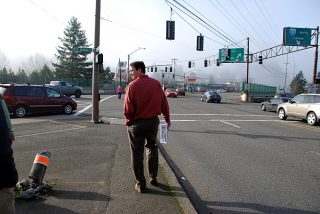
current auto-oriented commercial strip in February.
(Photos: M.Andersen/BikePortland)
Long-term plans are falling into place for a federally-subsidized biking and walking upgrade to one of Southwest Portland’s most important main streets.
And oh, it might come with a rapid bus or rail system, too.
Staff at the regional agency Metro announced last week that they weren’t going to recommend a $900 million light-rail tunnel beneath OHSU, instead sending the proposed Southwest Corridor high-capacity transit line on the surface of SW Naito and Barbur as it passes through Southwest Portland toward Tualatin and Tigard.
The decision means the possibility we wrote about during our Southwest Portland Week last winter — federal matching funds for major sidewalk upgrades and protected bike lanes through the Barbur commercial district and key feeders like Capitol Highway — is likelier than it was. However, it comes at the cost of direct transit access to Oregon Health and Science University, the city’s largest employer, and to the Hillsdale neighborhood.
In any case, none of the work is likely to happen for years. Metro’s schedule for the project anticipates completion between 2025 and 2035.

I’ll let Metro News writer Craig Beebe take it from here:
In short, planners say, the ends don’t justify the means – or the money – for either a deep-bored light rail tunnel to serve Marquam Hill and Hillsdale, or a shallower tunnel that would just serve Hillsdale town center.
Substantial construction impacts on nearby neighborhoods and sensitive medical facilities at Oregon Health & Science University drove the recommendation to remove a Marquam Hill light rail tunnel from further consideration, Southwest Corridor Plan manager Chris Ford said.
“The vibration impacts to OHSU facilities, the physical damage to Duniway Park for the north portal construction site and the constant truck traffic over multiple years in Lair Hill and Hillsdale are major community costs,” Ford said, “with only moderate gains in riders.”
Ford said the large price tag of a Marquam Hill light rail tunnel – as much as $900 million in latest estimates – was also a concern. It could cost 35 to 46 percent more than a surface route with only an eight percent bump in total transit ridership, according to the report.
In their recommendation, planners acknowledge that they heard a lot of public support for directly serving Marquam Hill with light rail. But they maintain that light rail or bus rapid transit on SW Barbur Blvd. or Naito Parkway, with elevators or escalators connecting to OHSU, would provide improved service to Marquam Hill with fewer neighborhood impacts and at a lower cost.
Advertisement
A surface route, Ford said, would also improve transportation safety in South Portland and along Barbur, including adding new bike and pedestrian infrastructure at two notorious bridges along a wooded stretch of the road. Such a route would be within walking distance of high-density South Waterfront, where OHSU is building new facilities.
OHSU officials have said they don’t want to be bypassed by high capacity transit, but have declined to say whether they’d insist on a tunnel. “As we grow, it’s essential that we continue to have excellent [transit] service,” OHSU associate vice president Brian Newman said in April. “That doesn’t necessarily mean a tunnel, but it does mean that the project needs to serve Marquam Hill and South Waterfront.”
A tunnel to serve Hillsdale alone would be shorter and shallower, and could work with either light rail or bus rapid transit.
But that tunnel option would actually result in fewer new transit riders and a longer trip from Portland to Tualatin, according to planners’ analysis, at a significantly higher price. Additionally, its prospect had raised significant community concerns about multiyear construction impacts in the Hillsdale business district, which would have to be torn up temporarily for the tunnel to be built.
Planners also note that Hillsdale is already well-served by frequent local buses, and TriMet is planning improvements as part of its Southwest Service Enhancement Plan.
All that means a direct transit tunnel might not be worth the added cost of $230 million for light rail or $140 million for bus rapid transit. Planners suggest exploring whether local buses might be able to use any dedicated transitway that’s built on Barbur or Naito from Hillsdale to downtown Portland.
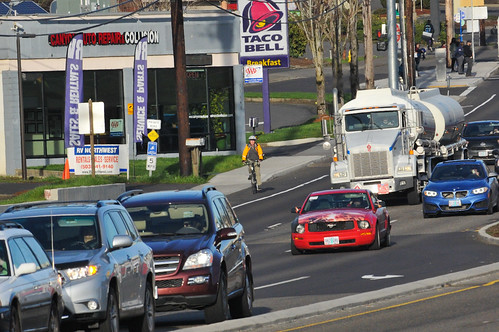
(Photo © J. Maus/BikePortland)
Beebe goes on to explore the still-open question of a tunnel that could directly serve Portland Community College’s huge Sylvania campus, which is likely to be a major driver of transit in the area.
Of course, it’s also totally plausible that none of this project will move forward. Tigard and Tualatin voters have approved ballot initiatives giving themselves veto power over major transit projects, and if a new bus or rail line can’t serve those cities, the ridership math falls apart. But as the planning process continues, last week’s staff recommendation (which hasn’t yet been approved by Metro committees or council) could gradually evolve into big news for biking on SW Barbur.
Got questions or opinions on the decision? You can learn more and share your thoughts online right now or at an open house tomorrow at Metro headquarters.



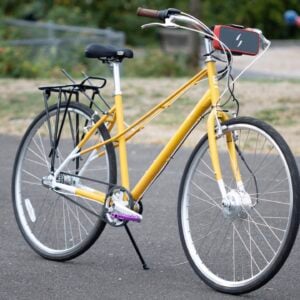
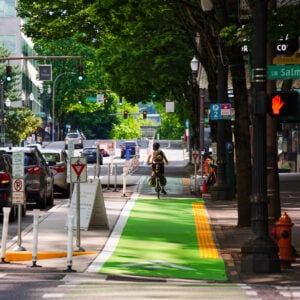
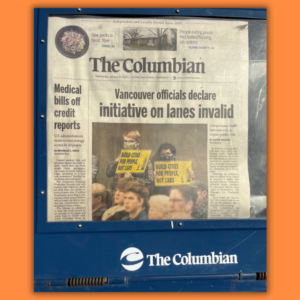
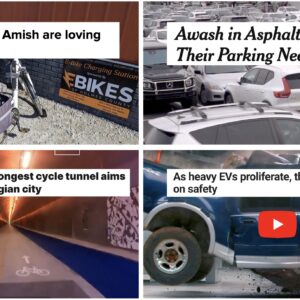
Thanks for reading.
BikePortland has served this community with independent community journalism since 2005. We rely on subscriptions from readers like you to survive. Your financial support is vital in keeping this valuable resource alive and well.
Please subscribe today to strengthen and expand our work.
It’s nice to see a local public agency backing away from a billion-dollar infrastructure project when less expensive and more inclusive options are available. And let’s face it: that $900 million price tag is a fantasy. The reality would be at least twice that.
Yes!
But what about the 10-20 year time lines for doing the surface thing?
Vision Zero in my daughter’s lifetime?
It’s frustrating for me to see those timelines, too. No kids here, but if I live to see 2035, I probably won’t be on a bike by then.
Here’s the thing, though: I see nothing in the plan that precludes some interim safety measures on Barbur. Not implementing ANY safety till ALL safety can be addressed is pathological perfectionism. I should know: it’s the kind of homeowner I am, and as a result, my kitchen, which needs a remodel I can’t afford, hasn’t been painted in 20 years. Because why paint when “any day now” I’m gonna gut it to the studs?
Makes perfect crazy-sense. Our local authorities have been so paralyzed by the recession and by voter outrage that there we are: crazy.
meanwhile the Western Bypass is fully underway.
http://oregonjta.org/region2/?p=highway99w
I know…different agency… but we, many of us, are funding both the highway expansion (now) and the shrinking of the car’s dominance on Barbur (someday).
That’s not the Western Bypass I’m familiar with. The Newberg Dundee pass has long been planned. The Western Bypass is a version of I-205 on the west side of the region that blows through Hillsboro, Forest Park and into Vancouver. That is likely not happening.
Yeah, I see the same arguments put forward to limit expanding bike lanes. If we can’t take both sides of parking on Skidmore or Killingsworth, then we can’t install bike lanes. It’s a difficult argument, and I understand we don’t want door zone lanes. But change happens slow, and something is presumably better than nothing.
The lanes on Broadway downtown, for example (at least for me) have acted as a buffer zone for parked cars and a noticeable indicator for people in cars that there is some space dedicated for bikes. I take the lane so I am not doored, but I feel safer taking the lane BECAUSE there is an existing bike lane, however flawed it is.
I don’t think the city is planning development around your reproductive cycle 😉
I agree with you – we just barely got the bridges fixed and it’s going to take a long time to get this planned and then developed. Just remember this problem happened over more than a century of road building and we’ll never get it perfect. But this was an important decision whether to invest in a tunnel or not and the assurance that we’ve done our due diligence to research the feasibility of such a tunnel will help make future planning a cleaner process.
Probably not, actually. While Trimet did encounter some geological problems when boring the west side light rail line, the entire west side light rail project, from downtown to Hillsboro was done for $964 million (in 1998 dollars). The tunnel portion was only delayed by about a year. All other MAX lines have come in on-time and under-budget.
Up in Seattle, Sound Transit has been creating dozens of miles of new light rail tunnels. The vast majority have come in ahead of schedule and under budget. Light rail tunnels are very common. We start seeing massive over-runs with large tunnels like the Boston Big Dig, and Bertha up in Seattle.
Good article Jonathan! I remember when the light rail went up Barbur and even through Multnomah to Garden home. Rail grade all the way. I am not sure but the rails might be still buried like they are in many Portland streets that are paralleled by many of the newer Max lines. I was already riding may of the routes when they were pulled out of service in the mid 50’s. hOW SOON WE FORGET WHEN SOCIETY BECAME ADICTED TO THE ARMORED PERSONNEL VEHICLES (SUV’s)
Thanks Tom. But just to be clear, I didn’t write this article. It was the work of our News Editor Michael Andersen.
In hindsight, the brief period of supremacy of the automobile will probably look really stupid to our descendants.
Yes. Though I use a different tense. 🙂
Heh. Yep. For BikePortland readers, that hindsight is already here.
unlikely. Pony Express, westward rail expansion, clipper ships, roman roads. All stepping stones of progress toward the current transportation system as are automobiles.
“Anyone who has never made a mistake has never tried anything new.” – Albert Einstein
Speaking strictly for myself here, I can look back at the stepping stones of progress and see stupidity where there was stupidity. That a stupid thing led to better things doesn’t mean that the stupid thing was the only possible route progress could have taken. The “reckless exuberance” with which internal combustion and automotive technology were adopted, the complete lack of imagination and foresight, the utter failure to put any check on their destructive path: all of it explains how we got where we are, but none of it excuses the mess we created on the way.
We can do better, but if we keep saying “it’s okay. because progress!”, we won’t.
hind sight is 20/20.
“…The “reckless exuberance” with which internal combustion and automotive technology were adopted, the complete lack of imagination and foresight, the utter failure to put any check on their destructive path: all of it explains how we got where we are, but none of it excuses the mess we created on the way. …” hawley
Use of motor vehicles for mass transportation represents business opportunity that puts food on the table. Motor vehicles are one of the greatest inventions ever created. Though like any tool, their misuse can have bad results. Someday, the seemingly relentless freeway commute between communities, primarily by single occupancy motor vehicle may go by the wayside. Until better community design eliminates the need for that approach to making a living, we’re likely stuck with it for awhile.
As far as serving OHSU (up and down the hill) from Barbur/Naito… have they considered if the Tram could be modified to add an intermediate stop? That would be a very efficient, pretty straight-forward mod. Although I suppose there are also capacity limitations due to the fixed car design (versus a ski-lift style loop). That’s probably too big a change to make.
It would have to be *exactly* in the middle of the run. Not sure what the people who live beneath the midpoint would think about that. And who would use that?
Why would it have to be exactly in the middle? I’m sure they wouldn’t love it, just like they won’t like the train in their backyard. As far as who would use it–the people that need to get from the new transit line to OHSU. I’m talking instead of whatever crazy escalator contraption they’re thinking that will run through currently-natural lands.
I think what has been considered is a series of escalators/elevators. I haven’t seen any actual images put forth by Metro yet.
Thanks, I know that’s been mentioned. I’m thinking as an alternative.
It will be similar to this, but probably without machine guns:
http://www.theguardian.com/world/gallery/2013/jul/31/outdoor-escalator-medellin-colombia-pictures
“…considered if the Tram could be modified to add an intermediate stop…”
That’s not “modified”; that’s a rip-it-out and do it over. As is, the angle of the lines on the tram make it a small engineering feat, and your proposal would make the lines even worse and therefore more expensive than the original. I’m not sure the upper terminal could take the additional load without having to do structural reinforcement. In short, it’s not a practical idea.
What is the timeline for ODOT’s promised Road Safety Audit? They said this Summer, but when? Also, a reminder for those interested to join the People for a Safer Barbur Blvd FB group. https://www.facebook.com/groups/peopleonbarbur/
We really need to stop building surface level light rail and to start investing in a cut and cover strategy. Already the lines through downtown are over capacity and slowed because they have to wait for signals, and the yellow line performance is abysmal when compared to driving. Until transit becomes somewhat similar in performance to driving we are going to have a hard time reducing SOV use.
SW 53rd needs another look into some sort of transportation option.
I’d love to see a Chicago ‘L’ Train-type transit system in Portland Proper. Almost all our light rail (yellow line excluded… sort of) follows either freight rail or interstates. This means it’s very difficult to live less than a 5-10 minute door-to-door walk from the train without also living next to something unpleasant. Our MAX lines are basically just for downtown and the outskirts; why can’t inner Portland have a reliable train system? Why are we stuck with just buses and a single streetcar line that’s so close to the river it might as well be in downtown?
50% of the metro surface area is parking. Maybe we should quit wasting so much area on making it easier for SOV drivers to make it harder for everyone else.
I like the idea of escalators from Barbur to Terwilliger, but I’d like at least one mountain bike trail there through Portland Parks property. Where would the escalators be located by the intersection of SW Hamilton and Barbur? The bus stops for riders many times at that intersection prone to right-hooks.
Hamilton is a long way from OHSU. Seems to me they’d do them in the vicinity of the Tram and the Gibbs St Ped bridge. Then they’d serve not only the new transit stop, but also as a walking alternative to the tram from South Waterfront (Gibbs St to the escalator).
no way man! an escalator through the woods is far more ecologically sensitive than a few people on mountain bikes :).
While I truly believe that a tunnel was the best option for connectivity and convenience, I’m actually a bit relieved that it was rejected. It was too spendy compared to the alternatives.
“However, it comes at the cost of direct transit access to Oregon Health and Science University, the city’s largest employer, and to the Hillsdale neighborhood.”
This needs to rapidly service OHSU. If they don’t add a spur of the aerial tram, the escalators will be a failure. Further, a surface rapid bus would be a poor choice when surface MAX is more resilient and more likely to spur density. Further, if this is a surface route, tons of land MUST be upzoned. There’s far too low-density zoning along Barbur.
I am of the opinion this is being blocked because the west hills have disproportionate political clout. The tunnels are likely being prevented because some rich people don’t want construction noise on a NEEDED infrastructure project.
Maybe they’re against the tunnel. But at least with the surface route, there’s an opportunity for the upzoning. That 900M construction cost doesn’t reflect all the lost opportunity for densification along the major urban stretch of the route if it were in a tunnel.
There’s very little potential for upzoning. The only reasonably flat land along inner Barbur is in Lair Hill, much of which is in the South Portland historic district. Any new building there has to go through the Historic Landmarks Commission, which is extremely to hostile new development.
I have heard no backing for a deep tunnel from up the hill. They (VA?) are building more parking up there now for visitors (most would never ride the rail+elevator anyway), and the employees are already well (and quickly) served by trimet’s current routes and ample free parking in neighborhoods all around those bus stops. A 5min walk and elevator to the lower tram terminal from Barbur says they won’t build anything here except perhaps a skybridge from a parking garage near Barbur and Condor (Go by Zip Line!)
only 20 to 30 more deaths on barbur until it is made safe! hope they aren’t me!
So South Waterfront needs two high capacity transit lines, plus a cycle track and tram, but the main campus of the city’s biggest employer gets a friggin escalator?! If we’re going to spend a bunch of money on the SW corridor, it really seems like Pill Hill should get some world class transit service.
Escalators done right are actually a great form of transit. Hong Kong has free escalators that run downhill in the morning during rush hour and up the rest of the time. They might be a bit slower than a bus, but you never have to wait to board them and they are covered and free.
55,000 people ride the escalator in Hong Kong every day. https://en.wikipedia.org/wiki/Central%E2%80%93Mid-Levels_escalator_and_walkway_system
I’ve read that Medellín has also benefited from large public escalators, which have substantially improved quality of life for a population of 12,000 mostly poor residents.
http://citiscope.org/story/2014/medellin-made-urban-escalators-famous-have-they-had-any-impact
Nobody tell Mo I said this, but I’ll be checking those out on our honeymoon there next month and looking forward to reporting back.
Oh, cool!
Congrats!!
Rejecting the tunnel is absurd. OHSU connectivity would have significantly increased ridership potential, and actually led to very noticeable mode share shifts.
Rejecting the tunnel also puts the nails in the coffin of the idea that light rail might still be chosen. So we’re going to be left with a surface “BRT” system that offers only very marginal improvements over existing bus service, especially since it won’t be in place for 10 to 20 years.
I put BRT in quotes btw because they only have to have 50% exclusive ROW to get it classified as brt and by the end of this you know it’s going to be the bare minimum as it goes through value engineering.
Sorry, I’m bitter about this whole process. I think it’s actually gotten in the way of possible improvements that could be done now because they are being punted to the SW Corridor process and the end result of the process is a subpar plan that won’t be implemented for years.
Actually, I come to the opposite conclusion. Skipping the tunnel may make light rail more affordable for this corridor.
I think we all agree that pushing safety improvements back to align with this project timeline is crazy. We need safety now!
BRT done right offers significant advantages over bus service as we know it – in fact, acts a lot like light rail/train as far as user experience – and costs less to build out than light rail. LRT operating costs, on the other hand, come in lower over the long haul because of having to pay fewer drivers. With autonomous vehicles looming in our future, who knows how that calculus will pencil out?
If we want to have any hope of adding more light rail in Metro we need to collect very fin grained detail on the efficiency and effectiveness of the new Orange Line (versus the most much derided WES line) AND how TriMet then balances bus line demand changes to maintain ridership quality and cost effectiveness.
The Orange Line has come in under budget but how it behaves in operation will affect transit projects for the next 20-30 years. Hopefully it’s success will help to make the anti-LRT skeptics seem more wingnutty.
What really scares me is the potential for Tigard or Tualatin to vote something like this down and stop the thing in it’s tracks (no pun intended)
I don’t know why we keep focusing on building expensive transit in overwhelmingly car-oriented neighborhoods. Clearly the residents there aren’t interested in giving up their cars in favor of public transit, otherwise why would they be living all the way out in Sprawlsville? The line isn’t going to be well-utilized if there aren’t many walkable destinations along the stations, unless every station is literally just a park-n-ride. It wouldn’t take much more to get a substantial number of people living in inner SE, NE, and North Portland to give up their cars and rely on public transit; the neighborhoods are walkable, dense, and not entirely car-oriented. Only reason it hasn’t happened yet is that all we have are buses, which are cramped, unreliable, and infrequent (I can’t believe PBOT actually boasts that its frequent service buses come every 15 minutes). Forget the suburbs, how about giving us a multi-billion-dollar train system? We’ll actually use it.
Do you really not consider the possibility that people are living in those neighborhoods because they just can’t afford similar quality housing closer in, or would appreciate being able to own a nice home with a yard AND not having to slog through traffic every day?
I think there is a possibility, but I start to question it when they pass ordinances that require public votes on transit projects, but not on road expansion projects…
Even within Portland only about 11% of commuters use transit. Just because you can get 51% to vote for dumb ordinances doesn’t mean we can or should ignore the minority that could benefit.
What alignment for the new trains do you have in mind ?
This, I think, is perhaps one of the central problems with expanding public and active transport. “The war on the car” is a false one. Adding transit or bike paths doesn’t mean suburban residents are forced to give up on their cars. It merely gives them a CHOICE about how to move around. Want to sit by yourself in a car for an hour? Most people in the ‘burbs do that now because it’s the only feasible option. Investing in transit/bike lanes means people have a choice. Many will still choose to drive, but a surprising number might actually NOT want to drive if presented with other options that are safe and relatively convenient. I understand these things have a not-insignificant cost, but if we stopped subsidizing single occupant vehicle use to the extent that we do and finally raise the gas tax (or change to a VMT tax) to pay for auto-infrastructure, we would just need to take general federal funds that are currently subsidising autos and shift it to transit and active transpo uses. Right now, roughly half a billion bucks from the Feds goes to ODOT that did NOT come from user fees (our federal income tax revenue provided that, not gas taxes). Granted, it needs to go to statewide projects, but that’s each and every year. $500,000,000.
Buses aren’t inherently cramped, unreliable and infrequent. Buses are big empty vehicles with lots of seats. Just because public bus transit services in this country have been traditionally underfunded and badly run, it doesn’t mean that a well-run system can’t provide a pleasant transit experience.
By the same token, there’s nothing inherently superior about rail. If you’ve ever ridden a crowded subway train in a big city, you know it can be as distasteful an experience as riding a bus. The supposed advantage–that of not competing with car traffic–can be built into a good BRT system, too.
I don’t have a dog in this fight–I rarely use Tri-Met. I just get annoyed with the “rails are inherently better” approach.
Hey, forgive me, J.E. My rant was based on a misreading of your comment. I’m sorry. I see now that you’re saying Tri-Met’s current, actual bus service is bad, not that all bus systems are bad. My apologies. Can’t argue that Tri-Met’s bus service is uncomfortable a lot of the time.
So why was the Zoo station approved and built back in the day?
It’s not enough bang for your buck to build a tunnel to one of Oregon’s largest employers, but it’s a-ok to build one to go look at a couple of depressed elephants?
The mind boggles!
I believe the Washington Park station was built almost as a freebie. The grades on the Tualatin mountains were too steep for a direct route, so it was either build a very long, circuitous, and therefore expensive route around, or tunnel through. A vertical shaft was then needed for material removal, ventilation, emergency access, etc., so making it a real stop on the line was an easy add.
It’s very common in long tunnel boring projects to divide the task in to segments that can be worked simultaneously.
See Gotthard Base Tunnel for how big tunnels are done these days. There was also an hour long Discovery Channel segment on it: entertaining for engineering and infrastructure geeks.
“So why was the Zoo station approved and built back in the day? …” Adam
Accessibility to a city wide recreational and educational destination. It was kind of a big deal to decide whether or not to spend extra money to build the zoo stop, which also accesses the children’s museum, Forestry Center, Arboretum and, Veteran’s Memorial, and Washington Park, outdoor concerts. And it’s very clear that space to park cars is limited at the zoo. Hopefully, there never will be a multi-story parking structure built up there to enable the use of more cars to and from this location.
As soon as I saw the attempts to link bike & ped improvements to not doing a tunnel, I knew it was doomed. There’s no reason those other things can only be done if the Purple Line isn’t in a tunnel. It’ll be interesting to see what sort of Rube Goldberg escalator/elevator people mover they come up with to get employees to OHSU and the VA.
I hope they factor in the cost of shuttle buses for when that escalator thing doesn’t work, and I hope it works in frozen precipitation, because the tram can’t get enough people up the hill when the road is frozen & buses can’t get up there (as happened maybe 6 years ago).
I had the same reaction you did to those tea leaves, but seems to me that there is a perfectly good reason that the Barbur bike/ped improvements wouldn’t be done without a tunnel: they’re going to cost tens of millions of dollars. Therefore they’re much more likely to happen if the feds are paying for half of them and if folks in the area perceive them as part of a coherent package that includes something almost everyone in the area would like, such as a shiny new transit line.
It says something about our commitment that we can’t get the safety improvements we need without linking it to a mega-project, though. We won’t get the best bike/ped improvements and we won’t get the best mass transit. Sure, it’s smart politically, and I never really expected a tunnel to happen (it’s just too expensive), but in the long run we would have been better off with it. If linkage like this is required, it’s a bad omen for improvements in other parts of the area.
I talked to Mary Felsh (sp) at Powell’s during the Tilikum crossing poster signing event a couple of weeks ago. I mentioned that I was really hoping for a tunnel. Her emotionless (and wordless) reaction told me what was coming. (I also told her that I was hoping that if it’s a Max line (vs BRT), I was hoping that it would be the “Purple” line….)
It’s unrealistic to expect one mega project to solve all our SW corridor needs and problems. We made the current mess through a series of decisions and relatively small projects and we can fix it as such.
Plus, people need safe ways to walk or bike to this future corridor..